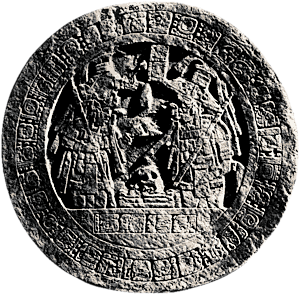 Today is
Today is The Maya long count calendar
The Maya named their days with a system of two parallel calendars. The ritual Tzolkʼin used numbers from 1-13 together with a sequence of twenty named days, which repeated in a 260-day cycle. The civil Haabʼ consisted of 18 months of 20 days, numbered 0-19, with another period of 5 days added to make a total of 365. These two calendars together (the calendar round) repeated in a 52-year cycle, and could be used to identify any date in what was likely an average lifespan. But to refer to historical dates in the past and future, the Maya used the long count, which was simply the number of days since the mythical creation date of 11 August 3114 BCE.
The long count is a number consisting of five numerals; but the first, third, and fourth place numerals use base 20, and the second uses base 18. Sources disagree on whether the fifth actually uses base 13 or 20. Here is a summary of how a complete date is constructed:
|
|
| |||||||||||||||||||||||||||||||||||||
The 360-day (20 × 18) tun may have actually been the basis of another calendar system.
The beginning of the current creation cycle, 11 August 3114 BCE, was designated 13.0.0.0.0. It was followed by 0.0.0.0.1, which implies a long count cycle of 13 bʼakʼtun (5125 years). Other sources, however, describe a unit of one piktun as 20 bʼakʼtun, implying that the bʼakʼtun should be base 20 like the other units.
The Tzolkʼin and Haabʼ dates of the original 13.0.0.0.0 were 4 Ajaw, 8 Kumkʼu; these are the starting points for the rest of the series. The next day was thus 0.0.0.0.1, 5 Imix, 9 Kumkʼu.
As an example of a long count date, Apollo 11 landed on the moon on 12.17.15.17.0, 4 Ajaw, 18 Sek. This means that this date was (12 × 144,000) + (17 × 7200) + (15 × 360) + (17 × 20) + (0 × 1) = 1,856,140 days since the creation date.
Use the form below to convert Gregorian to long count dates and vice versa. (Dates before 1582 use the proleptic Gregorian calendar, produced by extending the Gregorian calendar backward in time, with no year zero.) Increment the date to see the wheels of the calendar round turn.
It is easier to understand the long count dates by watching how they work. Here is one 365-day Haabʼ cycle, with day 1 of the next cycle added to show how they repeat. The beginning dates of the Tzolkʼin and Haabʼ cycles are highlighted. Since there are 20 Tzolkʼin day names, they correspond to the last (base 20) digit of the long count. Not all Tzolkʼin and Haabʼ combinations can actually occur. Note that 12/21/2012, like the original creation date, is the completion of a 13-bʼakʼtun cycle. (Compare it to an odometer rolling over from 99999 to 00000.)
| Tzolkʼin | Haabʼ | Gregorian | Long count | Tzolkʼin | Haabʼ | ||
|
russellcottrell.com | 3903 |